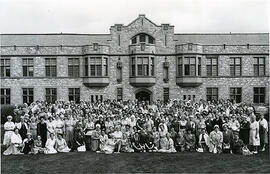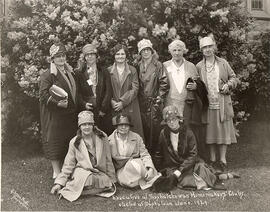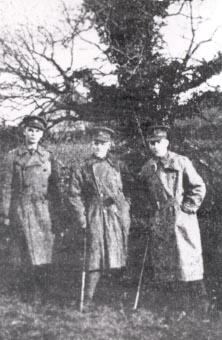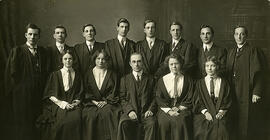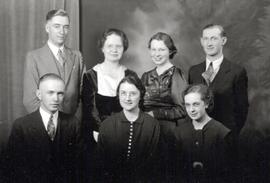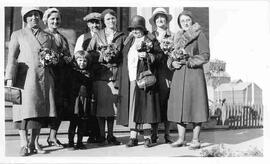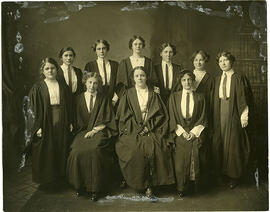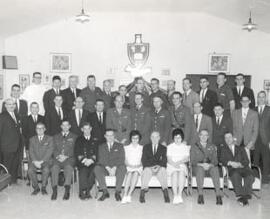Group photo of executive. Names on back of photo: "Seated: Agnes Elizabeth McDermid (treasurer), Georgina Esther King (president), Hope Weir (secretary). Standing: Olive Pearl King, Frances Helen Schiltz, Agnes Mary Valens, Marion Henley Dewdney, Sybilia Kydd, Marie Esler (vice president), May Kathleen Canty."
Bio/Historical Note: Georgina Esther King was the first female student registered in the University of Saskatchewan. She graduated with a degree in English in 1913, the first year for students who completed their entire time at the U of S. The April 1913 Convocation issue of The Sheaf indicates Georgina was a member of the Glee Club, a councillor in the Arts and Science Literary Society Executive, and president of the Pente Kai Deka Society. The class prophecy: “Miss G.E. King, teacher of art, will give lessons in china painting at her studio on Tor Hill.” Georgina King was born 28 April 1887 near Regina, Northwest Territories on Tor Hill, the family farm on Boggy Creek. Georgina married Edmund Sears Mandeville (1887-1962) in 1916. Jean Gordon Bayer, assistant professor of English at the U of S, was a bridesmaid. Georgina met her husband who worked with the Regina Water System facilities located on the King property. Janet Frances Mandeville was born in 1917 and her siblings Esther Ridley Mandeville Hickey (1918-2008) and Malcolm King Mandeville (1920-1926) soon followed. The young family relocated to Florida in 1925 after Malcolm suffered a stroke and a physician recommended he find a milder climate. He visited British Columbia but found it too cold, and after eleven trips by train they moved to St. Petersburg, Florida. In January 1926, Georgina and her three children went down to Coffee Pot Bayou and while wading got caught in the water. Janet and Esther were able to get out, but Georgina and Malcolm were pulled under and drowned. Janet almost went under going back into the water to retrieve her doll. The two sisters, age eight and seven, were found wandering in the area by workmen and taken home. The girls were reared by Georgina’s older sister, Janet Catherine King Estrich (1917-2001), and their father. Georgina and Malcolm are buried at Royal Palm South Cemetery, Saint Petersburg, Florida.
Bio/Historical Note: From the Greek for ‘five and ten,’ Pente Kai Deka was created on 8 April 1911 with the first 15 women students on campus – five “big sisters” and ten “little sisters.” Every woman entering the University automatically became a member. Eventually the group became its own directorate within the Student Representative Council, and the PKD president, the vice-president of the SRC. Activities of the group included a Big Sister-Little Sister Dance, June in January, Jeanboree, a Spring Tea and a Frosh Week fashion show. As the sexual revolution loomed large in the late 1960s women on campus grew increasingly ambivalent toward the group, which had been seen by many female students as irrelevant and antiquated since midway through the decade. It was this attitude, as well as the sheer increase in the number of women and students in general at the University by the late 1960s that led to the group’s demise after the 1968-1969 academic year.




